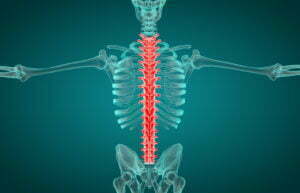28 Aug What Is Ankylosing Spondylitis?
Ankylosing spondylitis is an inflammatory condition that can cause damage to the spinal bones over time. The condition can cause a significant amount of pain for suffering patients and can thus diminish their quality of life. Unfortunately, there is no cure for ankylosing spondylitis. However, some therapies and treatments can help the amount of pain experienced by patients. Visiting a pain specialist is the best way to find a treatment plan that can help minimize pain, and improve the quality of life for those suffering from this condition.
Ankylosing spondylitis is an inflammatory condition that can cause the small bones in the spine to fuse over time. When these bones fuse, it makes the spine less flexible and can cause a person’s posture to appear hunched. The ribs of a person with ankylosing spondylitis can be affected as well. This may make it difficult for a person to breathe deeply. Men tend to be more affected than women with this condition and it begins to show its signs in early adulthood.
The earlier a person visits a physician with ankylosing spondylitis the better. The most common early symptoms include pain and stiffness in the lower back and hips. This tends to be more prevalent following periods of inactivity or early in the morning. The points in the body most likely to experience pain include the area between the base of the spine and the pelvis, vertebrae in the lower back, areas where tendons and ligaments attach to bones, the cartilage between the breastbone and the ribs, and hip and shoulder joints. If you notice pain in any of these areas it is best to be checked by a doctor immediately.
While ankylosing spondylitis primarily affects the spine, it can affect other parts of the body during complications as well. One of these complications is eye inflammation. It is typically rapidly onset and causes sensitivity to light and blurred vision. Compression fractures are another complication. Weakened vertebrae may become fractured and it can potentially lead to spinal cord injury. Problems with the aorta, the largest artery in the heart is another potential complication of ankylosing spondylitis. Inflammation of this artery can lead to problems with the heart. As a result, getting an accurate diagnosis for ankylosing spondylitis as soon as possible is key to beginning treatment and avoiding further complications of the disease.
The goal of treatment for those suffering from ankylosing spondylitis is to relieve pain and stiffness as much as possible. NSAIDs and TNF blockers are commonly prescribed for those suffering from the condition. In addition, physical therapy can greatly help patients regain range of motion. Ankylosing spondylitis is a difficult condition that can create a lot of pain for a patient and also make the patient self-conscious of their posture. While there is no cure, there are steps pain management physicians can take to help their patients live a better quality of life. The early the condition is diagnosed, the early a treatment plan can begin, thus giving the patient the best chance at a normal life.



